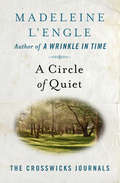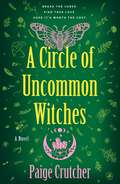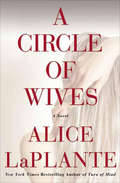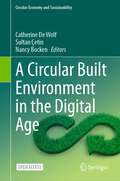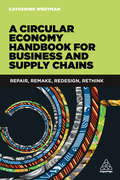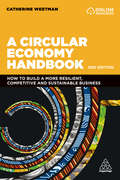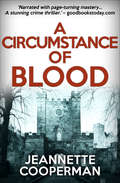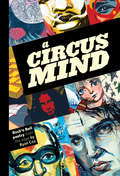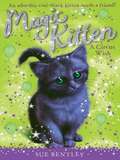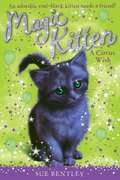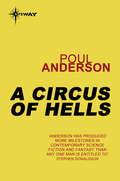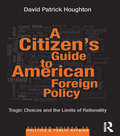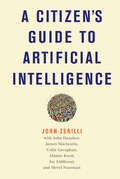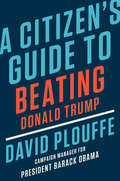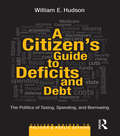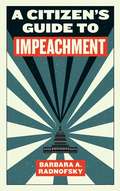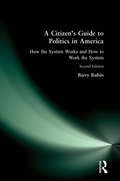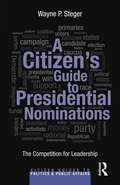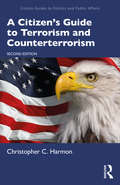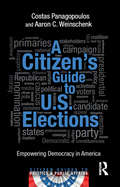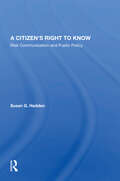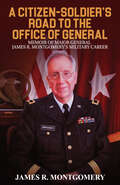- Table View
- List View
A Circle of Quiet: A Circle Of Quiet, The Summer Of The Great-grandmother, The Irrational Season, And Two-part Invention (The Crosswicks Journals #1)
by Madeleine L'EngleThe beloved author of A Wrinkle in Time takes an introspective look at her life and muses on creativity in this memoir, the first of her Crosswicks Journals. Every so often I need OUT. . . . My special place is a small brook in a green glade, a circle of quiet from which there is no visible sign of human beings. . . . I sit there, dangling my legs and looking through the foliage at the sky reflected in the water, and things slowly come back into perspective. Set against the lush backdrop of Crosswicks, her family&’s farmhouse in rural Connecticut, this deeply personal memoir details Madeleine L&’Engle&’s journey to find balance between her career as a Newbery Medal–winning author and her responsibilities as a wife, mother, teacher, and Christian. As she considers the roles that creativity, family, citizenship, and faith play in her life, L&’Engle reveals the complexities behind the author whose works—honored with the National Book Award, the Lewis Carroll Shelf Award, and countless other prizes—have long been cherished by children and adults alike. Written in simple, profound, and often humorous prose, A Circle of Quiet is an insightful woman&’s elegant search for the meaning and purpose of her life. This ebook features an illustrated biography of Madeleine L&’Engle including rare images from the author&’s estate.
A Circle of Time (Time Travel Mysteries)
by Marisa Montes"I helped you. Now you help me."As fourteen-year-old Allison Blair lies comatose in the hospital, she hears in her head the voice of Becky Lee Thompson, pleading for help and pulling Allison back in time to 1906--and into Becky's body. But why? Is it to prevent Becky's tragic death, or the death of Joshua, the boy who loves her? Allison must remain in the past--fortified by her own growing feeling for Joshua, and Becky's will--to make sense of the layers of mystery, blackmail, and mistaken identity so that history will be altered.Becky's spirit struggles to keep Allison's body alive. Can Allison save Becky and Joshua and return to her own body before time runs out?
A Circle of Uncommon Witches: A Novel
by Paige Crutcher"A mind-bending, heart-wrenching adventure to unravel a curse as intricate as any lacework. Unforgettable!" - Ava Morgyn, author of The Bane WitchA witch generationally cursed to never find true love sets out to break the spell cast on her family, and must team up with the last person who wants to help her – the witch who set the curse in the first place.Doreen MacKinnon is doomed to die of a broken heart - if she can’t break the centuries old curse placed on her family.Three hundred years ago, Ambrose MacDonald, a powerful male witch, fell in love with a MacKinnon. And when the MacKinnon witches forbade him from seeing his love, by secretly hiding her away, he retaliated by cursing the family and its future generations to never find love. But it wasn’t without a cost. Now, Ambrose is imprisoned by those same witches, trapped in a tempest and doomed to outlive everyone he has ever loved.But Doreen isn’t like the other MacKinnon witches. As the 13th generation of the MacKinnon line, Doreen is one of the most powerful witches in centuries… and one of the loneliest. So when she discovers where Ambrose has been trapped, she releases him to help her break the curse, once and for all. Ambrose agrees to help, but with his own motive: vengeance. He plans to use her as bait to enact his revenge on her family. Together, they enter a series of trials, which take them to a castle in Scotland, off a cliff, and into a world beyond their wildest dreams. As they work together, sparks start to fly, but soon Doreen must choose how far she is willing to go to break the curse, and what she's willing to sacrifice.Paige Crutcher's A Circle of Uncommon Witches is a story of adventure, romance, and destiny, that asks: is true love worth the cost?
A Circle of Wives: A Novel
by Alice LaPlanteFrom the New York Times–bestselling author of Half Moon Bay. “Marriage is as mysterious as murder in LaPlante’s captivating psychological thriller” (People). An Indie Next PickA LibraryReads SelectionAn Amazon Best Book of the Month (Mysteries & Thrillers)A Daily Candy Best Book of MarchOne of More magazine’s “Five Thrillers Not to Read After Dark” When Dr. John Taylor turns up dead in a hotel room, the local police uncover enough incriminating evidence to suspect foul play. Detective Samantha Adams, whose Palo Alto beat usually covers petty crimes, is innocently thrown into a high-profile case that is more complicated than any she has faced before. A renowned reconstructive surgeon and a respected family man, Dr. Taylor was beloved and admired. But beneath his perfect façade was a hidden life—in fact, multiple lives. Dr. Taylor was married to three very different women in three separate cities. As the circumstances surrounding his death emerge, Detective Adams finds herself tracking down a murderer through a tangled web of marital deception and revenge. New York Times–bestselling author Alice LaPlante’s haunting and complex novel of family secrets dissects—with scalpel-like agility—the intricacies of desire and commitment, trust and jealousy. “Exhilarating and smart, A Circle of Wives is a wild ride of love, loss, marriage and murder, with a finale that’s provocative, thrilling and grand. It all shows that while some deaths are a mystery, so, too, are some loves.” —San Francisco Chronicle
A Circular Built Environment in the Digital Age (Circular Economy and Sustainability)
by Catherine De Wolf Nancy Bocken Sultan ÇetinThis open access book offers a comprehensive exploration of the digital innovations that have emerged in recent years for the circular built environment. Each chapter is meticulously crafted to ensure that both academic readers and industry practitioners can grasp the inner workings of each digital technology, understand its relevance to the circular built environment, examine real-life implementations, and appreciate the intriguing business models behind them. Our primary objective is to blend scholarly knowledge with practical inspiration by providing real-life case studies for each innovation. The authors, who possess extensive expertise in their respective fields, have contributed chapters dedicated to digital technologies within their areas of specialization. The book is organized into three distinct parts. The first part focuses on data-driven digital technologies and delves into how their capabilities can facilitate the transition to a circular built environment. Essential aspects such as building information modeling (BIM), digital twins, geographical information systems (GIS), scanning technologies, artificial intelligence (AI), data templates, and material passports are explored as vital tools for data collection, integration, and analysis in the context of circular construction. In the second part, various digital technologies for design and fabrication are introduced. Topics covered include computational design algorithms, additive and subtractive manufacturing, robotic manufacturing, and extended reality. These discussions shed light on how these technologies can be leveraged to enhance design and fabrication processes within the circular built environment. Finally, the last part of the book presents emerging digital concepts related to business and governance. It explores the role of deconstruction and reverse logistics, blockchain technology, digital building logbooks, and innovative business models as enablers of circularity in the built environment. The book concludes with a chapter dedicated to digital transformation and its potential to propel the built environment towards a regenerative future. In addition to the substantive content, the book features forewords and perspectives from esteemed experts, providing valuable economic and creative insights to complement its comprehensive approach.
A Circular Economy Handbook for Business and Supply Chains: Repair, Remake, Redesign, Rethink
by Catherine WeetmanA Circular Economy Handbook for Business and Supply Chains is an easily digestible and comprehensive handbook that provides a clear guide to the circular economy. Real examples across a range of market sectors help businesses, students and policymakers understand the theory and fast-developing practice of the circular economy. A holistic framework for the 'design and supply chain', business models and enablers helps generate ideas, and the book includes tools to help you get started. Whilst growing global consumption presents fantastic business opportunities, our current 'linear' systems - take some materials, make a product, use it and then throw it away - are not fit for purpose. The circular economy unlocks this problem by 'decoupling' resources from consumption. Switched-on businesses are re-thinking product design, material choices, business models and supply chains. A Circular Economy Handbook for Business and Supply Chains is a 'must-read' for anyone who wants to apply the circular economy today.
A Circular Economy Handbook: How to Build a More Resilient, Competitive and Sustainable Business
by Catherine WeetmanWINNER: 2018 Les Plumes des Achats & Supply Chain - The Committee Special Prize As we learn more about the climate and biodiversity crisis, it is clear that how we make and consume things is a major part of the problem. Extraction and processing of materials, fuels and food makes up about half of global greenhouse gas emissions and over 90% of biodiversity loss and water stress. Many modern businesses deplete resources, destroy ecosystems and dump waste and pollution at every stage - harming human health along the way. Governments, businesses and think-tanks see the circular economy as the way forward. Now in its second edition, A Circular Economy Handbook is a guided tour through the concepts and the practicalities. A unique framework systematically explores the range of circular interventions, including product and supply chain design, material choice and supporting business models. How does it really work for business? What circular approaches are emerging in food, fashion, consumer technology, packaging and other sectors? How do these reduce risk, improve resilience and build profitable, future-fit organizations? With over 300 real examples from around the world, this is a must-read for businesses, students and policymakers. This new edition has been extensively updated to include the latest trends, thinking, research and solutions, with a new chapter on packaging and 30 new company snapshots.
A Circumstance of Blood
by Jeannette Batz CoopermanA problem student is suspected of murder in this contemporary mystery thriller set at a Jesuit school by the author of The Broom Closet. Fr. Colin McAvoy, a Scottish Jesuit priest and principal of the Matteo Academy, wants to create a wholesome learning environment for as many students as possible—whether or not their parents can pay. Then Colin receives a new pupil who puts his charitable convictions to the test. Graham Dennison has been accused of trying to kill his mother. Colin wants to refuse him, but the funds they could raise from Graham’s lawyer father would do a lot of good for the academy. To put his mind at ease, Colin brings in an old friend, journalist Sarah Markham, to develop a profile of the young man. She’s not convinced Graham is violent at all. But when another student is found dead from a possible drug overdose, the entire school is thrown into a panic. Now it’s up to Sarah to get to bottom of the murder. Was she wrong about Graham? Or is something even more sinister afoot at Matteo Academy?
A Circumstantial Narrative Of The Campaign In Russia
by Anon. Eugène LabaumeThe 29th Bulletin of the Grand Armée of the French Empire arrived in the heart of Paris on the 16th of December 1812, causing an uproar and consternation. Napoleon admitted that he had lost huge numbers of the troops during the Russian campaign and had been forced to retreat. In a master work of half-truths and omissions, Napoleon attempted to put all of his talents of spin to revealing the extent of the disaster, as if to cheer the war-weary population of his Empire to the end with a flourish--" The health of his Majesty was never better."The health of the remaining survivors as they struggled back through the staggering cold, with few rations, constant attacks and little hope, was very different to that of their master. Captain Labaume trudged through the ice in the company of Napoleon's step-son Eugène with the remnants of the Italian troops. With each step he grew more determined to ensure that the loss of his comrades would not be in vain. He wrote his version of the events during the march using gunpowder and melted snow for ink. Published after Napoleon's fall in 1814, Labaume revealed the shocking truth behind the campaign: the incompetence, bloodshed, hunger, selfishness, horror and suffering. It caused a sensation in France and was rapidly translated into English, going through many, many editions.As visceral, gripping and graphic an account of the horrors of war as ever was written.Author -- Labaume, Eugène, 1783-1849.Translator -- Anon.Text taken, whole and complete, from the third edition published in London. Printed for Samuel Leigh, in the Strand, 1815Original - viii, 442 p.Illustrations - The Plans cannot be included due to their size [A3]
A Circus Mind: Rock'n Roll Poetry from the Edge
by Zela Lobb Julia Minamata Andrew Wessels Ellen Sloan Jacqui Oakley Dushan Milic Samone Murphy Ryan Cox Andy Potts Elissa ParenteCircus Mind is a compilation of rock n roll inspired poems by Ryan Cox. The book weaves through the annals of rock n roll to paint an expressive history of the bands and their music. Exploring the reaches of every corner of the music world from the Rolling Stones recording of Exile on Main St in Nellcôte, France to the Willie Nelson long-haired outlaw country of the 70's and the socially conscious island rhythms of Bob Marley to the explosive grunge rock of the Seattle trio, Nirvana. Carefully crafting intricate rhymes with surreal imagery of the real life events that characterized the careers of many of the defining artists of the 20 century, Ryan delivers a unique perspective and fresh take of the rock n roll elite. Along with the vivid written imagery, the book is accompanied with a striking collection of illustrations by an international collection of six illustrators.
A Circus Wish #6
by Andrew Farley Sue Bentley Angela SwanSadie can't wait to get involved with the local circus youth group, especially when it turns out she's really good at acrobatics! Sadie wonders what to do when her best friend Jenny suddenly starts acting mean and jealous toward her. Luckily she finds a lonely kitten who can make everything better! .
A Circus Wish (Magic Kitten)
by Sue BentleyAfter she discovers she's good at acrobatics, Sadie can't wait to get involved with the local circus youth group. However, Sadie's best friend Jenny suddenly starts acting jealous toward her. Luckily, Sadie finds a lonely kitten that can make everything better.
A Circus of Hells: A Flandry Book
by Poul AndersonAce Lieutenant Dominic Flandry was not a man easily swayed from his duty to the Empire; not, that is, until galactic vice king Leon Ammon offered him a million-credit bribe, a voluptuous woman called Djana, and a chance to explore a dark and treasure-laden moon.Yet within the desolate peaks and valleys of that strange world of ice and shadows, Flandry found more than he had bargained for. Supposedly barren, the planet swarmed with a hideous race of strange, inhuman creatures, infernally controlled by a deranged and brilliant computer brain. Each, like a piece in a bizarre and vicious chess game, was programmed to kill. And although Flandry did not know it - so was the woman he loved.
A Citizen of the Country
by Sarah SmithBook 3 in The Vanished Child trilogy. Excellent historical mystery set in Flander, France, pre-WW1.
A Citizen's Guide to American Foreign Policy: Tragic Choices and the Limits of Rationality (Citizen Guides to Politics and Public Affairs)
by David Patrick HoughtonAmerican foreign policy often looks like a trail of man-made debris and disaster. Of course, the explanations for many poorly-made decisions are rather complex. In this brief and cogent analysis, Houghton shows us that understanding American foreign policy often comes down to recognizing the cognitive limitations of the decision-makers, which affects the foreign policy process. Then there is the nature of the decisions themselves. Quite a few decisions in American foreign policy involve ‘tragic’ choices, where leaders are effectively confronted with a series of progressively bad or uncomfortable options. And it is equally clear that some policies are not the product of any one individual’s preferences, but emerge as a consequence of the way in which complex modern governments with large bureaucracies operate. Written with the interested layperson in mind, as well as students of international affairs, this Citizen’s Guide to American Foreign Policy asks questions like, "Why do presidents so often do things which seem to be directly against the national interests of the United States – not just in retrospect, but even at the time?" "Why do there seem to be so many fiascoes in US foreign policy?" "Why does Congress sometimes tie the hands of the president in foreign affairs?" "Why do presidents seem to respond more to opinion polls or to what’s on CNN and Fox News than they do to the core interests of the United States?" Houghton’s overview helps us see past the partisan in-fighting that too often obscures the central issues in foreign affairs. This is vital, required reading for all readers who wish to better understand America’s involvement in the world.
A Citizen's Guide to Artificial Intelligence
by John ZerilliA concise but informative overview of AI ethics and policy.Artificial intelligence, or AI for short, has generated a staggering amount of hype in the past several years. Is it the game-changer it's been cracked up to be? If so, how is it changing the game? How is it likely to affect us as customers, tenants, aspiring home-owners, students, educators, patients, clients, prison inmates, members of ethnic and sexual minorities, voters in liberal democracies? This book offers a concise overview of moral, political, legal and economic implications of AI. It covers the basics of AI's latest permutation, machine learning, and considers issues including transparency, bias, liability, privacy, and regulation.
A Citizen's Guide to Beating Donald Trump
by David PlouffeA voter's playbook on making a difference in the 2020 election and beyond from the most recognized and most successful political strategist in the countryIf you've asked yourself the question, what more can I do to make sure Donald Trump does not continue to occupy the Oval Office on January 20, 2021?--then this book is for you. <P><P>A playbook for the common citizen, A Citizen's Guide to Beating Donald Trump addresses the many things individuals can do in 2020 every day, without having to leave their jobs, move to Iowa, or spend every waking moment on the election. <P><P>In A Citizen's Guide to Beating Donald Trump, Plouffe's message is simple: the only way change happens, especially on scale, is one human being talking to another. It won't happen magically, it won't happen because of debates and conventions, it won't happen because of ads. It will happen because citizens take action. And Plouffe is here to help, with specific strategies and tailored talking points to make sure your time and energy aren't wasted. He lays out why different activities the average citizen can take can make a difference to getting to 270 electoral votes, how people can go about doing them and examples of where it's worked in the past. <P><P>There are at least 65 million Americans who are likely committed to voting against Trump. It is entirely in our control to grow that number and make sure the support materializes in actual votes. Plouffe arms us with advice on how to defend against misinformation online, how to create and spread content, how to register and get out the vote early, how to make a difference in the battlegrounds and how to stay involved after the big election. <P><P>Filled with stories from the last sixteen years, both successes and failures, as well as political strategies that have evolved in the wake of the breakthrough campaign that Plouffe masterminded, A Citizen's Guide to Beating Donald Trump is a pragmatic, specific, and very motivational guide for the path forward. <P><P><b>A New York Times Bestseller</b>
A Citizen's Guide to Deficits and Debt: The Politics of Taxing, Spending, and Borrowing (Citizen Guides to Politics and Public Affairs)
by William E. HudsonAmerica is currently involved in one of the worst economic crises of modern times. As alarm increases over how the government will balance the budget, handle the debt, and maintain prosperity for the future, the minutia of debts and deficits remains incomprehensible to many. Why is it so hard to find ways to resolve the fiscal crisis? This brief and intelligible book is a guide to understanding both the difficulties involved in managing the federal budget and why the on-going fiscal crisis is so significant for America’s future. In order to introduce the reader to the basic composition of federal spending and to the ways that the government raises revenue, Hudson begins his guide with a "map" clarifying how to navigate the federal budget. He defines basic financial vocabulary and outlines concepts by using clear charts and diagrams that both provide basis for discussion and illustrate key points. With this budget map in mind, the second part of the book lays out how the partisan divide in America helps explain the fiscal crisis. Hudson analyzes the debate on the extent of the fiscal crisis, the ways that political parties have tried to solve it, and the political events and institutions that have surrounded the crisis. This citizen’s guide reveals how differing views of America inform the arguments over deficits and debt. By the time readers finish the book, they will understand that the conflict over deficits and debt is not simply about where to cut or add spending, but instead is a struggle over national priorities and visions for the future.
A Citizen's Guide to Impeachment: A Citizen's Guide to Impeachment
by Barbara RadnofskyImpeachment is based upon “those offences which proceed from the misconduct of public men, or, in other words, from the abuse or violation of some public trust … as they relate chiefly to injuries done immediately to the society itself.” —Alexander Hamilton A non-partisan guide to a precise understanding of the rules and history of impeachment . . .Spotlighting in particular the precise rules of impeachment—including an explanation of the crucial grounds for impeachment, the famous “high crimes and misdemeanors”—the book also details its origins in British law, the rules as set out by the founding fathers in the Constitution, and their application throughout the history of our democracy.That history involves a detailed chronology of the nineteen instances of impeachment that have taken place—of judges, presidents, and officials from the cabinet and congress—throughout American history, including the very first impeachment conviction of an America official: that of a federal judge who seemed to have developed dementia.All of which makes A Citizen’s Guide to Impeachment a fascinating read about a unique aspect of our democracy, as well as a useful, one-of-a-kind guide for citizens in a participatory government.
A Citizen's Guide to Politics in America: How the System Works and How to Work the System
by Barry RubinThis book is an antidote for civic apathy and disillusionment. It takes the reader step-by-step through the process of successful action for change -- from the germ of an idea to finding allies, getting the word out, and building the critical mass of people, energy, and support to accomplish the desired result.Filled with abundant practical examples and guidelines for success, the book covers all the bases: how to recognize that it's time for action; how to lobby decision makers; how to go to court; how to use information; how to use the internet effectively; how to get media attention; how to influence public opinion; how to mobilize grassroots support; how to form coalitions; how to organize an initiative or referendum; and more.
A Citizen's Guide to Presidential Nominations: The Competition for Leadership (Citizen Guides to Politics and Public Affairs)
by Wayne P. StegerPresidential nominations in the United States can sometimes seem like a media circus, over-hyped and overly speculative. Even informed citizens might be tempted to tune them out. Yet understanding the process, one distinct to American politics, is crucial for civic participation. If presidential elections are about who will lead the nation, presidential nominations are about who appears on the ballot.?This concise and coherent Citizen’s Guide examines who has power in presidential nominations and how this affects who we as citizens choose to nominate, and ultimately to sit in the Oval Office. Political scientist Wayne Steger defines the nominating system as a tension between an "insider game" and an "outsider game." He explains how candidates must appeal to a broad spectrum of elected and party officials, political activists, and aligned groups in order to form a winning coalition within their party, which changes over time. Either these party insiders unify early behind a candidate, effectively deciding the nominee before anyone casts a vote, or they are divided and the nomination is determined by citizens voting in the caucuses and primaries. Steger portrays how shifts in party unity and the participation of core party constituencies affect the options presented to voters. Amidst all this, the candidate still matters. Primaries with one strong candidate look much different than those with a field of weaker ones. By clearly addressing the key issues, past and present, of presidential nominations, Steger’s guide will be informative, relevant, and accessible for students and general readers alike.
A Citizen's Guide to Terrorism and Counterterrorism (Citizen Guides to Politics and Public Affairs)
by Christopher C. HarmonThis Citizen’s Guide addresses the public policy issues of terrorism and counterterrorism in the United States. Written for the thinking citizen and student alike, this succinct and up-to-date book takes a “grand strategy” approach toward terrorism and uses examples and issues drawn from present-day perpetrators and actors. Christopher C. Harmon, a veteran academic of military theory who has also instructed U.S. and foreign military officers, organizes his book into three sections. He first introduces the problem of America’s continued vulnerability to terrorist attack. Part II examines the varied ways in which the U.S. is fighting terrorism, highlighting the labors of diverse experts, government offices, intelligence and military personnel, and foreign allies. The book outlines the various aspects of the U.S. strategy, including intelligence, diplomacy, public diplomacy, economic counterterrorism, and law and law-making. In Part III, Harmon sketches the prospects for further action, steering clear of simple partisanship and instead listing recommendations with pros and cons and also including factual stories of how individual citizens have made a difference in the national effort against terrorism. New to the Second Edition • Adds coverage of the Islamic State, explained in terms of its character, rise, and relative collapse under coalition pressures.• Focuses on the growing right-wing terrorist threat, domestically as well as internationally.• Covers additional schools of militancy including anarchism; variants of communism and especially Maoist insurgency; and the Iranian/Shia terrorist threat throughout the Middle East and Europe, among others.• Analyzes the current published White House strategy for countering terrorism.
A Citizen's Guide to U.S. Elections: Empowering Democracy in America (Citizen Guides to Politics and Public Affairs)
by Costas Panagopoulos Aaron C. WeinschenkPolitical observers routinely lament that American democracy is broken, and many of them blame electoral malfunction. But is the system really broken? Panagopoulos and Weinschenk make the case that citizens are empowered to fix what’s wrong with electoral politics and renew democracy in America, all within the institutional setup and framework of the existing system. Put simply, much of what is broken can be fixed if people stop throwing up their arms and start rolling up their sleeves to do the hard work of building our democracy. This book provides an overview of the basic features that characterize contemporary elections in the United States and includes discussions about voter participation and decision-making patterns, money in elections, and the role of parties and the media in presidential, congressional and state and local races. It also outlines some of the most important trends and challenges in the current system. As a call to action, each chapter features potential solutions to the challenges that exist in U.S. elections.
A Citizen's Right To Know: Risk Communication And Public Policy
by Susan G. HaddenIn 1986, after the disastrous accident at the Union Carbide plant in Bhopal, Congress passed the Emergency Planning and Community Right-To-Know Act. Under this act, many business facilities became subject to new reporting requirements with respect to the presence of hazardous substances. Hadden, an associate professor at the Lyndon B. Johnson School of Public Affairs, conducted surveys relating to this act.
A Citizen-Soldier’s Road to Office of General: Memoir of Major General James R. Montgomery's Military Career
by James MontgomeryAs a young boy growing up in Knoxville, Tennessee, James R. Montgomery's sense of patriotism and duty to country is sparked by the United States' entry into World War II. Too young to serve his country, he joins Junior ROTC in high school and takes the first steps in a long and illustrious military career in the U.S. Army Reserve. A Citizen-Soldier's Road to the Office of General traces Montgomery's career from those early days of marching on a football field through active duty in Greenland and finally into his role as a Reserve officer. The book details the Reserve officer's job – the never-ending preparation for mobilization to active duty – and highlights the dedication of men and women willing to serve during the troubled times of the Cold War. The picture that emerges is one of how mentors, friendships, luck, and persistence influence Montgomery's journey through a maze of military pathways to his ultimate rank as major general of the 310th Theater Army Area Command.
